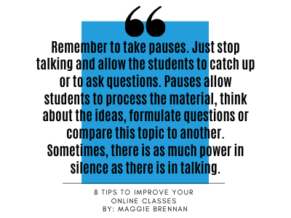A guest post by Maggie Brennan
Below are helpful tips to teach effectively to maximize learning, keep the attention of all the students, and manage various problems. This article is especially useful for teachers with little experience in online learning environments.
By now you have probably given a few live online classes and are settling into a routine of what to do and how to do it. Perhaps you have noticed that sometimes these classes work well and other times nothing goes right and you just want to give up. In either of those cases, keep in mind these helpful tips to make your class a productive work environment for everyone involved.
Tip 1:
Start the class by introducing the topic and your lesson/meeting goals. This may seem obvious, but often it is not done. It may be perfectly clear to you what topics you are teaching, but it is not to the students. Especially for large classes, it is easy to lose the thread of the conversation, to not remember what topic was taught yesterday or for a student to get distracted because his little brother is playing video games in the next room. Just being in a different physical location than the speaker makes it much more difficult to focus on the topic at hand and leads to distractions and lack of concentration. To counteract this, orient the class at the start by providing an outline for the lesson, a study guide, a bullet point list of topics or a graphic related to the subject matter. You can provide this onscreen in the moment, or better yet, send it ahead of time by email, Google Classroom, etc. When they follow along more efficiently, it leads
to a more productive class for all parties.
Tip 2:
Remember to take pauses. Just stop talking and allow the students to catch up or to ask questions. Pauses allow students to process the material, think about the ideas, formulate questions or compare this topic to another. Sometimes, there is as much power in silence as there is in talking.
Tip 3:
Repeat yourself. Say each main concept a second or third time. By repeating your ideas a few times with slightly different words, you greatly increase comprehension. This is especially important for online classes. Not only is focus and concentration an issue for kids of any age studying from home, but issues with spotty Internet access or lack of a stable Wi-Fii creates dropouts in audio or video. Students often miss a word or phrase,
but if you repeat yourself, the entire class can maintain the thread of the conversation.
Tip 4:
Don’t speak into the camera for the entire class. Change the view or change the activity. Most of the online class platforms allow you to share your screen and show something else on your computer, or to use a whiteboard. Even if it is a momentary break, it is helpful to change it up a bit. It doesn’t need to be a complicated, high-tech addition to the class. It could just be a simple “yes or no” question to the group where everyone writes the answer in the chat section of the screen.
Tip 5:
Ask questions of your participants or have them explain concepts to others. This is another way to break up the monotony, change the view and help redirect the focus of the class. It also keeps the students involved (and awake!). This is a good way to check for comprehension as well.
Tip 6:
Make sure your participants use headphones or earbuds. This eliminates that horrible feedback noise from the computer audio and also takes away the background noises from the other people who are walking around or talking in the student’s home.
Tip 7:
Be careful of what appears on screen behind you. Try to find a well-lit area of your home that provides a blank wall for your background. If that is not possible, find a background with something simple like a desk, some books, a plant or a picture frame. It is not a good idea to have a window on screen, as the light will be distracting and will make your face appear much darker. A quiet, private place where you won’t be interrupted is always best.
Tip 8:
Dress as if you were going to work. Represent yourself professionally and be attentive to your appearance, even though you are probably in your bedroom. This may sound obvious, but unfortunately there have been many viral videos online of people who didn’t brush their hair or who forgot to wear pants and then got up and walked away!
With a little practice, I firmly believe we can bring the quality of online classes very close to the level of in-person meetings or classroom teaching. There is nothing like being face-to-face with people, but unfortunately for the time being that is just not possible. In the meantime, we can emphasize the positive elements of this online environment, try new techniques and explore this new medium of virtual classes and meetings.
Maggie Brennan is an international education consultant based in Argentina. She can be reached at [email protected] on LinkedIn: @MaggieBrennanBA.

